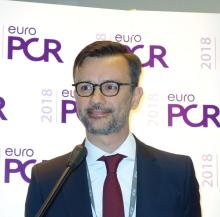The long-term favorable impact of the early interventional strategy was striking: At 5 years, the rate of the primary composite endpoint of death, MI, or urgent revascularization was 13.9% in the early PCI group, roughly half of the 27% rate in the medically managed group. And this intention-to-treat analysis understates the true benefit of early PCI, since by the 5-year mark fully 51% of patients in the medically managed arm had crossed over to PCI.
The difference in the composite endpoint was driven largely by the early PCI group’s lesser need for urgent revascularization, defined as revascularization performed during any unplanned hospital admission for symptoms prompting revascularization. Most of these urgent revascularizations were prompted by in-hospital positive cardiac biomarkers, ECG changes, or unstable angina.
Of note, patients who underwent early PCI had a long-term primary endpoint closely similar to that of a control group of patients who had stable angina with no hemodynamically significant stenoses.An important finding that was not apparent during shorter-term follow-up is that, by the 5-year mark, the early PCI strategy conferred a significant reduction in the risk of acute MI: 8.1% versus 12%. This difference was mainly due to the early PCI group’s lower rate of nonprocedurally related spontaneous MI: 6.5% compared with 10.2% in the control group, for a 38% relative risk reduction.

